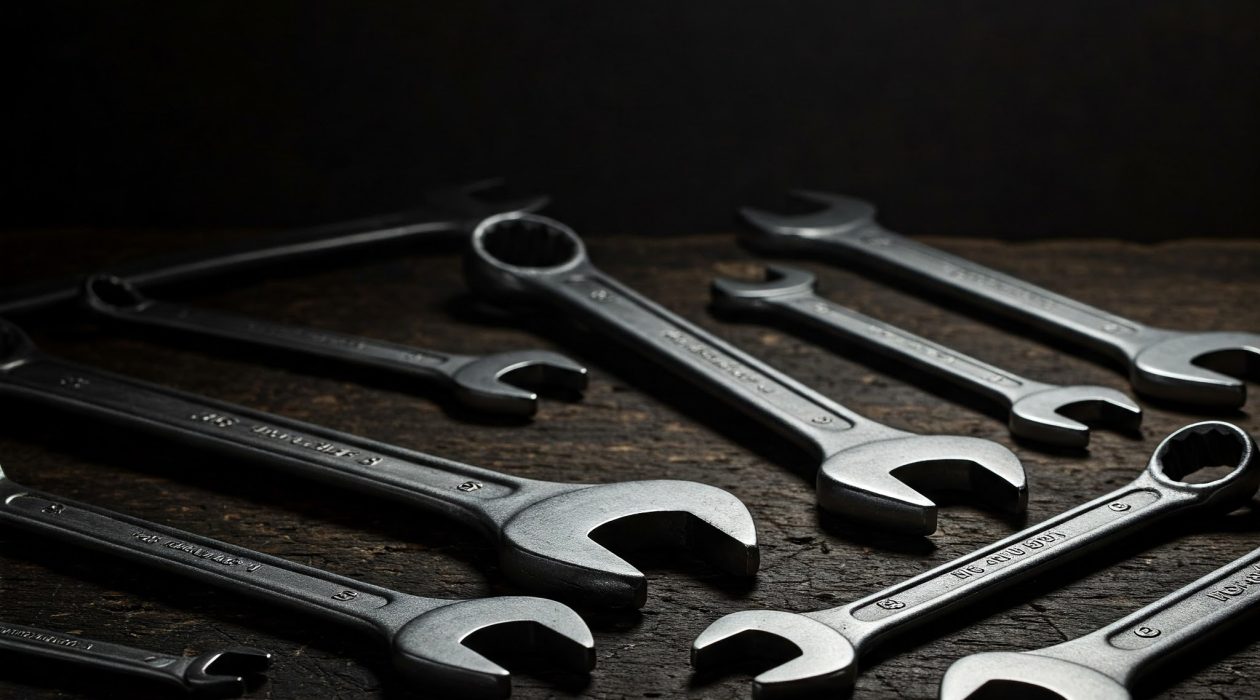Welcome to our comprehensive wrench guide, where we explore the different types of wrenches, their uses, and valuable tips. This guide is for both seasoned DIY enthusiasts and beginners. It aims to help you navigate the world of wrenches confidently.
Understanding the various types of wrenches is crucial for any project. Our guide will walk you through the essentials. We cover everything from wrench anatomy basics to the materials used. Our goal is to give you a thorough understanding of wrench types, helping you make informed decisions for your next project.
With this wrench guide, you’ll gain the knowledge and skills to tackle any task with ease. Our guide is packed with useful information, including tips and tricks for effective wrench use. By the end of this guide, you’ll be well-versed in the world of wrenches and ready to take on any challenge that comes your way.
Key Takeaways
- Learn about the different types of wrenches and their uses
- Understand the basics of wrench anatomy and materials
- Discover valuable tips for effective wrench use
- Explore the various applications of wrenches in DIY projects
- Get the most out of your wrenches with our expert guide
- Improve your skills and confidence with our comprehensive wrench guide
Understanding the Basics of Wrenches
For DIY projects, having the right tools is crucial. The wrench is a versatile and widely used tool. It’s used for tasks like tightening bolts and loosening stuck parts. We’ll explore the basics of wrenches, including what makes a wrench, its anatomy, and common materials used.
DIY enthusiasts need to understand wrench basics for efficient project completion. DIY wrench uses span from tightening screws to repairing car engines. Knowing different wrench types and their uses helps DIYers choose the right tool confidently.
What Makes a Wrench
A wrench applies torque to objects, like bolts or nuts. It has a handle and a head that contacts the object. The head’s shape varies by wrench type and task.
Basic Wrench Anatomy
The wrench’s anatomy includes the handle, head, and jaw. The handle is for the user’s grip, and the head contacts the object. The jaw grips the object and adjusts for different sizes.
Common Wrench Materials
Wrenches are made from steel, aluminum, and chrome vanadium. Steel wrenches are strong and durable. Aluminum wrenches are lightweight and resistant to corrosion. Chrome vanadium wrenches combine steel and chrome for high strength and durability.
Understanding wrench basics helps DIYers choose the right tool for their projects. Whether it’s a simple DIY task or a complex repair, a wrench is essential for success.
Essential Types of Wrenches Every DIY Enthusiast Should Know
For DIY projects, the right tools are crucial. Wrenches are among the most vital tools in any DIY toolkit. The best wrenches for DIY projects are key to project success. They help in tightening loose bolts and loosening stuck parts.
Common wrenches for DIY projects include adjustable, socket, and pipe wrenches. Each has its own use and benefits. Adjustable wrenches are versatile, socket wrenches offer precision, and pipe wrenches are perfect for pipes.
Here are some of the best wrenches for DIY projects that every enthusiast should consider:
- Adjustable wrenches for versatility
- Socket wrenches for precision work
- Pipe wrenches for gripping and twisting pipes
In conclusion, the right wrenches are crucial for DIY project success. By investing in the best wrenches for DIY projects, enthusiasts can ensure efficient and effective project completion.
| Wrench Type | Use | Benefits |
|---|---|---|
| Adjustable Wrench | Various tasks | Versatility |
| Socket Wrench | Precision work | Torque and precision |
| Pipe Wrench | Gripping and twisting pipes | Secure grip |
Adjustable Wrenches: Your Versatile Workshop Companion
Adjustable wrenches are a must-have in many workshops. They provide versatility, making them crucial for various tasks. Their adjustable jaw fits different bolt and nut sizes, perfect for projects needing multiple sizes.
Adjustable wrenches excel in tight spaces and unusual bolt sizes. They’re ideal for tasks where fixed wrenches won’t do. Their adaptability makes them a go-to tool in many situations.
Different Sizes and Applications
Adjustable wrenches vary in size, from small to large. The wrench’s size determines the bolt sizes it can handle. For instance, a small wrench fits 6-10 mm bolts, while a larger one accommodates 12-24 mm bolts.
Advantages and Limitations
Adjustable wrenches offer versatility, ease of use, and convenience. Yet, they come with risks like slipping and stripping bolts if not used correctly. Choosing the right size and using it properly are key to avoiding these issues.
Maintenance Tips
To maintain your adjustable wrench, clean and store it correctly. Regularly wipe it with a cloth to remove dirt and apply oil to moving parts. These simple steps will help your wrench last longer and perform better.
| Wrench Size | Bolt Size Range |
|---|---|
| Small | 6-10 mm |
| Medium | 10-18 mm |
| Large | 18-24 mm |
Mastering Socket Wrenches for Precision Work
To excel in using wrenches, understanding socket wrenches’ role in precision tasks is crucial. A wrench guide is invaluable for selecting the right socket wrench. With the right tools and practice, mastering socket wrenches becomes achievable.
Key benefits of socket wrenches include:
- Increased precision and control
- Improved efficiency and speed
- Reduced risk of damage to bolts and surrounding material
When choosing a socket wrench, consider your project’s type and precision needs. A wrench guide offers insights and recommendations for informed decisions.
By following these tips and practicing, you’ll master precision work. Always refer to a trusted wrench guide for effective socket wrench use.
| Socket Wrench Type | Precision Level | Recommended Use |
|---|---|---|
| Ratchet Socket Wrench | High | Automotive and machinery repair |
| Impact Socket Wrench | Medium | Construction and heavy-duty projects |
| Manual Socket Wrench | Low | General-purpose and DIY projects |
Specialized Wrenches for Specific Tasks
Having the right tools is crucial for DIY projects. Specialized wrenches are designed for specific tasks, making them vital for DIY enthusiasts. They can save time and effort, whether you’re working on plumbing or automotive projects.
We will explore common specialized wrenches like pipe wrenches, Allen wrenches, torque wrenches, and impact wrenches. Each has unique characteristics and uses. Understanding these differences is key for successful DIY projects.
Pipe Wrenches
Pipe wrenches grip and twist pipes, essential for plumbing. They’re made of heavy-duty materials and have long handles for extra leverage.
Allen Wrenches
Allen wrenches, or hex keys, drive bolts and screws with hexagonal sockets. They’re used in automotive and construction projects, available in various sizes.
Torque Wrenches
Torque wrenches apply a specific torque to bolts or nuts, crucial for precision. They’re used in automotive and aerospace projects, where accuracy is paramount.
Impact Wrenches
Impact wrenches loosen stuck bolts and nuts, common in construction and automotive projects. They’re powered by air or electricity, available in different sizes and styles.
Understanding specialized wrenches and their uses empowers DIY enthusiasts. Whether tackling plumbing or furniture building, the right wrench is essential.
| Wrench Type | Use |
|---|---|
| Pipe Wrench | Gripping and twisting pipes |
| Allen Wrench | Driving bolts and screws with hexagonal sockets |
| Torque Wrench | Applying a specific amount of torque to a bolt or nut |
| Impact Wrench | Loosening stuck bolts and nuts |
Proper Wrench Maintenance and Care
To maximize the use of your best wrenches for DIY projects, maintaining and caring for them is crucial. Regular cleaning and proper storage are key to preventing damage and extending their life. By adhering to a few simple guidelines, you can keep your wrenches in optimal condition. This ensures they remain a valuable asset in your DIY toolkit.
For cleaning, a soft cloth and mild soap are sufficient. Steer clear of harsh chemicals or abrasive materials that can harm the finish or weaken the wrench’s structure. Store your wrenches in a dry, secure spot, away from moisture and extreme temperatures.
Cleaning and Storage
- Use a soft cloth to wipe down your wrenches after each use
- Store your wrenches in a dry, secure location
- Avoid exposing your wrenches to moisture or extreme temperatures
Rust Prevention
To ward off rust, apply a thin layer of oil or silicone-based lubricant to metal surfaces. This protective measure keeps your wrenches running smoothly. Regularly checking for rust or corrosion helps catch issues early, preventing major problems.
When to Replace Your Wrenches
Wrenches will eventually need replacement, even with diligent care. Look out for signs of wear or damage, such as cracks, dents, or rust. Investing in the best wrenches and following proper maintenance ensures they remain reliable and effective for years.
Safety Guidelines When Using Wrenches
When working with types of wrenches, safety is paramount. Whether you’re a seasoned pro or a DIY novice, it’s crucial to take precautions to avoid accidents. Always choose the right wrench for the task, ensuring a snug fit to prevent slipping and stripping.
Never use types of wrenches that are damaged or worn out. They can break or slip, leading to harm. Regularly check your wrenches for wear and replace them when needed. Proper handling and storage are also key to preventing accidents and extending your wrenches’ life.
Here are some additional safety tips to keep in mind when using types of wrenches:
- Always wear protective gear, such as gloves and safety glasses, when working with wrenches.
- Ensure the work area is well-lit and clear of clutter to prevent tripping hazards.
- Use wrenches in a well-ventilated area, away from flammable materials.
- Never use wrenches near open flames or sparks.
By adhering to these safety guidelines and taking the necessary precautions, you can significantly reduce the risk of accidents and injuries when working with types of wrenches. Remember, safety should always be your top priority. With the right mindset and precautions, you can ensure a safe and successful project.
| Wrench Type | Safety Precaution |
|---|---|
| Adjustable Wrench | Ensure proper adjustment to prevent slipping |
| Socket Wrench | Use the correct socket size to avoid stripping |
| Pipe Wrench | Wear gloves to prevent hand injury |
Professional Tips for Using Wrenches Effectively
Mastering the use of a wrench requires practice and patience. A detailed wrench guide offers insights into grip techniques, common errors, and efficiency tips. Understanding the basics and applying them in practical scenarios is crucial for proficiency.
The grip technique is a fundamental aspect of wrench usage. Proper grip significantly impacts torque and control. A firm yet comfortable grip is essential for safety and efficiency. Common mistakes include using the wrong wrench size, applying too much force, and neglecting wrench maintenance.
Proper Grip Techniques
- Choose the correct wrench size for the task
- Hold the wrench with a firm, yet comfortable grip
- Apply gentle, consistent pressure
Common Mistakes to Avoid
- Using a wrench that is too small or too large
- Applying excessive force, which can lead to injury or damage
- Neglecting to maintain the wrench, leading to rust or wear
By adhering to these guidelines and avoiding common pitfalls, one can enhance wrench usage skills. A well-maintained wrench and correct technique are vital for project success. Always consult a reliable wrench guide for specific advice and guidelines.
| Wrench Type | Recommended Use |
|---|---|
| Adjustable Wrench | Tightening or loosening bolts and nuts of various sizes |
| Socket Wrench | Working with sockets and ratchets for precise control |
Choosing the Right Wrench for Your Project
For DIY projects, having the right tools is crucial for success. The wrench stands out as a must-have for any DIY enthusiast. With numerous wrench types available, selecting the right one for your project can be daunting. Wrench uses span from tightening loose bolts to loosening stuck parts.
In DIY projects, wrenches are vital for tasks like assembling furniture, fixing bikes, or repairing appliances. Automotive work also relies on wrenches for tasks such as changing oil, replacing brakes, or tuning engines. Plumbing tasks, like fixing leaky faucets, unclogging drains, or installing new pipes, also require wrenches.
When choosing a wrench, consider the material you’re working with, the size of bolts or nuts, and the torque needed. Selecting the right wrench ensures a successful outcome and prevents damage to tools or materials.
DIY Projects
- Assembling furniture
- Fixing bikes
- Repairing appliances
Automotive Work
- Changing oil
- Replacing brakes
- Tuning engines
Plumbing Tasks
- Fixing leaky faucets
- Unclogging drains
- Installing new pipes
Common Wrench Problems and Solutions
Working with the best wrenches for DIY projects requires knowledge of common issues. A frequent problem is a loose or worn-out handle. This can cause the wrench to slip, potentially leading to injury. Regularly check your wrenches and replace any damaged parts.
Rust or corrosion is another common problem. It can weaken the wrench and reduce its effectiveness. To prevent this, clean and dry your wrenches after each use. Apply a rust-inhibiting coating to protect them from the elements. For those who frequently work with best wrenches for DIY projects, a maintenance routine is crucial to extend tool lifespan.
- Stuck or jammed parts: Apply penetrating oil and let it sit for a few hours before attempting to remove the stuck part.
- Dull or worn-out teeth: Use a file or sharpening stone to restore the teeth to their original sharpness.
- Broken or bent handles: Replace the handle with a new one, or use a handle repair kit to fix the damage.
Being aware of these common problems and taking preventive measures ensures your best wrenches for DIY projects stay in good condition. They will continue to serve you well for many years.
Building Your Essential Wrench Collection
Building a comprehensive toolkit starts with the right wrenches. A well-stocked collection makes tackling various projects easier and more efficient. Understanding the different types of wrenches and their uses is key.
Beginner’s Set
A beginner’s set should cover the basics. This includes adjustable wrenches, socket wrenches, and combination wrenches. These tools handle most tasks and projects. A starter kit with a variety of wrenches is a good place to begin.
Advanced Tools
As you gain experience, expand your collection with specialized wrenches. This includes pipe wrenches, Allen wrenches, and torque wrenches. These tools are crucial for more complex projects and tasks.
Professional Kit Recommendations
For professionals or serious DIY enthusiasts, a high-quality wrench set is a must. Look for a kit with a range of wrenches, such as ratcheting wrenches and impact wrenches. These tools offer precision and versatility for demanding projects.
Mastering Your Wrench Skills
This ultimate guide to wrenches has equipped you with the knowledge and confidence for a variety of DIY projects and car repairs. The versatile wrench is essential for everything from simple household tasks to complex machinery overhauls. Whether you’re an experienced handyman or new to DIY, learning to use and maintain wrenches unlocks a world of wrench guide possibilities.
Practice and patience are crucial to becoming a wrench expert. Begin with simple tasks, try out different types, and always focus on safety. Soon, you’ll handle even the most complex mechanical challenges with confidence. This will boost your self-reliance and problem-solving abilities. So, embrace the power of the wrench and start your DIY journey!


